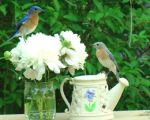
|
||
|
|
|
|
| Forgot Password | ||
Flowers that Attract Birds
Posted by MariaBBB |
Added on : May 29, 2010 12:57am |
Viewed 2746 times
| 0 Comments | This article is also in birds
and blooms
Attracting birds to your yard is easy. Providing shrubs and trees for shelter, a source of water and brightly colored flowers that produce an abundance of seeds creates a haven for birds. With a little care and planning, you can design a landscape complemented with simple annuals purchased at the nursery or long-lasting perennials that will provide seeds for birds year after year. Birds and blooms go together.
 Daisies come in a variety of colors from the pure white of the Shasta daisy to richly colored gold and yellow. The painted daisy comes in a variety of hues of pink, rose and red. Planted in a sunny location, daisies require little care and bloom profusely in mid summer, bringing a splash of color to any landscape. These delicate flowers produce seed heads that attract finches, cardinals, sparrows and others. Simply allow daisies to go to seed at the end of the season and watch the birds flock to your garden as the weather becomes colder.
Daisies come in a variety of colors from the pure white of the Shasta daisy to richly colored gold and yellow. The painted daisy comes in a variety of hues of pink, rose and red. Planted in a sunny location, daisies require little care and bloom profusely in mid summer, bringing a splash of color to any landscape. These delicate flowers produce seed heads that attract finches, cardinals, sparrows and others. Simply allow daisies to go to seed at the end of the season and watch the birds flock to your garden as the weather becomes colder.
Sunflowers, known for their appeal to birds, produce large heads of seeds that will attract a wide variety of birds. Available in a wide range of colors and styles, sunflowers provide a striking display of color, ranging from traditional yellow to maroon and mahogany. Planted behind existing gardens, gigantic sunflowers make a dramatic statement, while miniature sunflowers are small enough for a sunny corner of the yard. When left to go to seed, these flowers provide an excellent food source for birds.
Zinnias grow quickly and are easy to care for. Varieties range in size from dwarf 8-inch plants to 36-inch plants. A wide range of color provides many opportunities to complement your garden scheme. Zinnias produce large seeds loved by a wide range of birds and serve double duty to attract butterflies during the blooming season. These fiery flowers are a must-have for anyone who wishes to attract wildlife to his garden. Do not deadhead the plants at the end of the season. Simply allow them to go to seed naturally and enjoy the flocks of birds that gather to harvest the seeds.
Rubeckia, commonly known as black-eyed Susan, brings a rich golden hue to late summer gardens. This remarkable flower is available in a variety of shades of yellow and gold. Variegated varieties feature blended rings of color that make a dramatic contrast with plainer varieties. These produce thick seed heads and when left to go to seed provide seeds for wild birds.
Purple coneflower paired with Rubeckia creates visual contrast in the garden. This quick-growing plant returns each year with bigger and brighter blooms. It produces a sturdy seed head that supports the weight of large birds, which stop to reap the harvest.
Coreopsis, known as golden glow, provides an excellent background plant that features either single or double golden yellow blooms. Varieties range from 2-foot plants to those that are 7 feet or more. These feature branching blooms atop tall slender stems with fluted foliage. Paired with other blooming plants, coreopsis brightens the landscape and produces seeds that attract a variety of birds in fall and winter.
 Daisies come in a variety of colors from the pure white of the Shasta daisy to richly colored gold and yellow. The painted daisy comes in a variety of hues of pink, rose and red. Planted in a sunny location, daisies require little care and bloom profusely in mid summer, bringing a splash of color to any landscape. These delicate flowers produce seed heads that attract finches, cardinals, sparrows and others. Simply allow daisies to go to seed at the end of the season and watch the birds flock to your garden as the weather becomes colder.
Daisies come in a variety of colors from the pure white of the Shasta daisy to richly colored gold and yellow. The painted daisy comes in a variety of hues of pink, rose and red. Planted in a sunny location, daisies require little care and bloom profusely in mid summer, bringing a splash of color to any landscape. These delicate flowers produce seed heads that attract finches, cardinals, sparrows and others. Simply allow daisies to go to seed at the end of the season and watch the birds flock to your garden as the weather becomes colder.


Be the first one to comment on this article